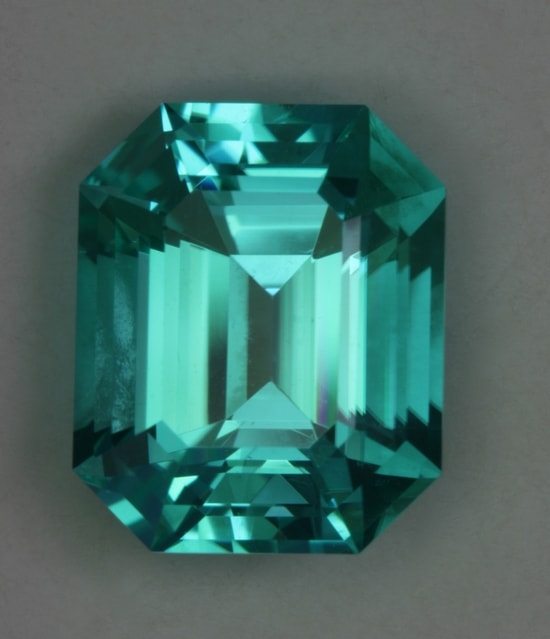When Paraiba from Brazil first hit the market in the late 1980s and was accepted as a natural beauty, many attempts were made to stretch English to express the wonderment of its beauty. Its hue/color was compared to Windex blue, electric blue etc. and its visual impact as vivid, neon, etc. With the advent of the discovery of paraiba like (cuprian) tourmaline in Nigeria, the chorus became even louder because now the trade had more material to invest their effort in. Finally the much larger deposit of paraiba like tourmaline from Mozambique, with its larger clean gemstones has helped put this variety of tourmaline into the stratosphere. Along the way to this pinnacle of promoting there have been many disappointments. (one of the reasons I did not send in samples of tourmaline from Mozambique, that turned out to be cuprian, earlier,was the numerous disappointments in finding new deposits of paraiba like tourmaline) The biggest and most important failure, was not finding copper in tourmaline from Afghanistan/Pakistan. Stories circulated about special agents scouring the countryside and paying exorbitant prices for the individual pieces of precious rough. Dealers with many years of experience waited with bated breath, to get analytical reports back from the worlds best gemological laboratories, to confirm the magic of copper. Then the euphoria and hype hit the wall of negative reports, the beautiful cyan blue tourmaline from Afghanistan/Pakistan did not have copper, it was colored by lowly iron. Prices that were reaching for the sky, moderated and very little has been heard about the material since. (I was actively buying rough from Afghanistan at the time and my principle dealer promised me that if I visited him in California, he would let me hold his piece of paraiba from Afghanistan/Pakistan. By the time I got there the wave was past and we talked of other things.)
At about the same time I had made contact with a high end gemstone dealer in Kentucky. I wanted to get acquainted with him and show him my collection. It was while I was visiting him, that I first saw high quality emerald cuts made from the cyan colored, want to be copper bearing, tourmalines from Afghanistan/Pakistan. They are impressive, but something is lacking. I have since made another trip to visit him and brought my new spectrometer with me, to check out a couple pieces of unheated Paraiba tourmaline from the original pocket that are still in the rough state. He was interested in having only one type of gemstone tested for himself, The cyan emerald cuts from Afghanistan/Pakistan. He said his customers just can not believe that they do not contain copper. Well my spectrometer verified that they do not contain copper. So what is going on and what is missing, when they have the identical color of some high grade copper bearing tourmaline?
The gemstones are bright, but they do not have the same high level of neon glow found in the best copper bearing tourmaline. When I include the neon glow along with the cyan color, into the visual presence of the gemstone, I feel that cuprian/copper bearing/paraiba-like/Paraiba is more exceptional than the iron based cyan colored gemstones. I say best copper bearing tourmaline, because the neon property does vary in my collection of copper bearing tourmaline from Mozambique along with sea foam from Afghanistan/Pakistan. I have also found that I have a similar non copper bearing cyan stone in the collection that has a very good color, but not a high level of visual presence, when compared with top quality copper bearing tourmaline.
So what is the bottom line here. Cyan is a beautiful color anywhere it is found in gemstones. The presences of copper in tourmaline does not guarantee that the gemstone will have a neon glow about it. Without a superior neon glow, cyan copper based tourmaline is not intrinsically superior to cyan iron based tourmaline. What causes the neon nature of a color to be expressed, is a good question. I think that is revolves around the level of the spectral purity of the stone’s color and its perceived brightness.
I have limited the discussion to cyan blue because it is the color that is most desired in copper based tourmaline and I can compare it with cyan, iron based tourmaline. But I definitely see indications of copper, as a chromophore, in other bright colors of tourmaline. Whether these other colors have more or less of the neon glow, than similar colors produced by other chromophores, I am not prepared to say. Maybe I will have more information when I get my upgraded spectrometer operational.

